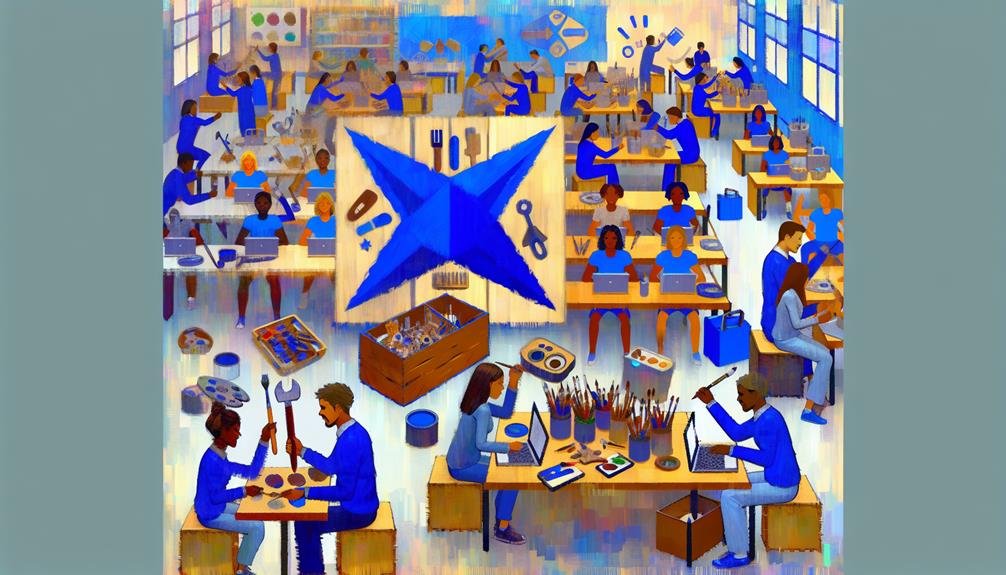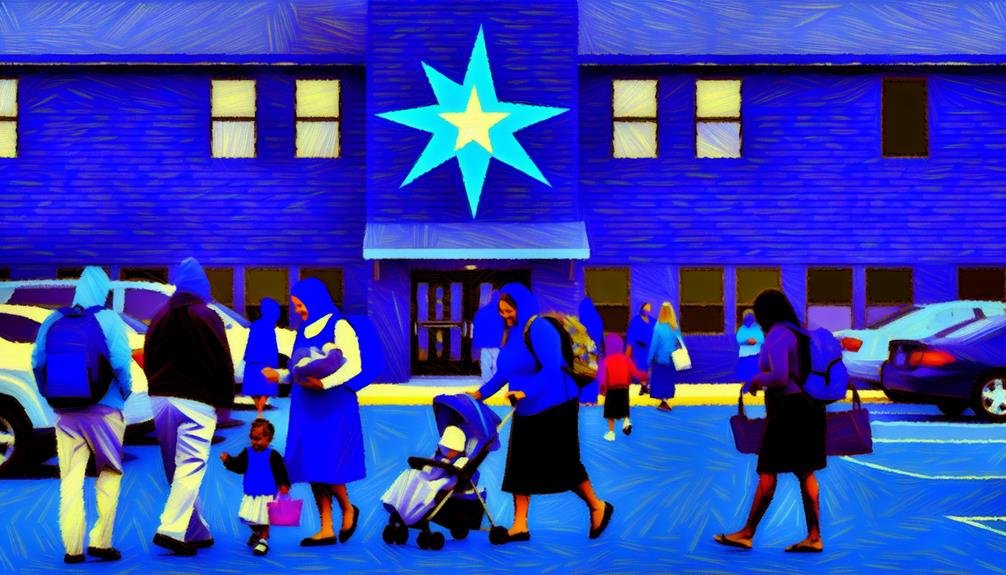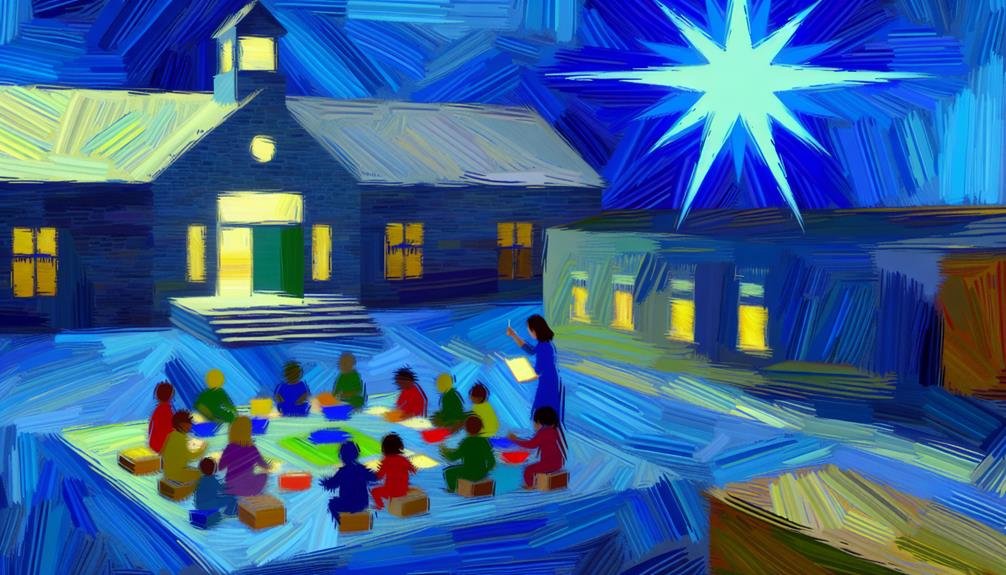High school child care programs offer students a chance to sprinkle their days with giggles, kindness, and life lessons. They dive into the wacky world of tiny tots, learning patience, empathy, and teamwork along the way. It’s like a wild adventure where every tantrum and triumphant smile teaches them something new. But beware, these programs also snag a bit of time from their packed schedules and might throw a curveball or two. However, the rewards are sweeter than a dessert buffet! If you keep exploring, you’ll discover a treasure trove of growth, real-world skills, and heartwarming moments.
Takeaways
- Develops skills in early childhood education and caregiving.
- Provides real-world experience for students.
- Supports parents with resources and assistance.
- Fosters community engagement and collaborations.
- Enhances students’ empathy, responsibility, and communication skills.
Benefits for Students
High school child care programs offer students the opportunity to develop valuable skills in early childhood education and caregiving, enhancing their academic experience and preparing them for future careers in related fields. These programs provide a hands-on learning environment where students can interact with young children, honing their communication, problem-solving, and patience skills. By working with children of different ages and backgrounds, students gain a deeper understanding of child development and behavior, preparing them for careers in teaching, counseling, or childcare.
Through these programs, students also learn the importance of responsibility and time management as they juggle schoolwork with hands-on caregiving tasks. This real-world experience helps them build confidence and leadership skills, setting them up for success in their future endeavors.
Additionally, by participating in child care programs, students develop empathy, compassion, and a sense of fulfillment from positively impacting the lives of young children. Overall, these programs not only enrich students’ academic experience but also shape them into well-rounded individuals ready to make a difference in the field of early childhood education.
Real-World Experience
Real-world experience is like the ultimate teacher – it’s where the magic happens!
High school child care programs offer students a chance to immerse themselves and engage in hands-on learning opportunities.
From changing diapers to planning activities, these programs provide practical skill development that prepares students for the real deal.
Hands-On Learning Opportunities
Hands-on learning opportunities in child care programs provide students with valuable practical experience essential for their future careers. These hands-on experiences go beyond textbooks and lectures, allowing students to immerse themselves in the real-world dynamics of child care.
Picture this: a high school student gently cradling a baby, learning the art of soothing and comforting them. It’s not just about changing diapers or preparing bottles; it’s about developing empathy, patience, and nurturing skills that are crucial in the field of child care.
Practical Skill Development
Students enrolled in child care programs gain invaluable practical skill development through immersive real-world experiences that mirror professional settings. These programs offer a unique opportunity for students to hone a diverse set of skills that are not only essential in the child care industry but also highly transferable to a wide range of professions.
Here are four ways in which high school child care programs contribute to practical skill development:
- Communication Skills: Students learn to effectively communicate with children, parents, and other professionals in a clear and compassionate manner.
- Problem-Solving Abilities: By facing various challenges in a child care setting, students develop strong problem-solving skills and learn to think on their feet.
- Time Management: Balancing caregiving responsibilities, educational tasks, and personal commitments teaches students the importance of efficient time management.
- Teamwork and Collaboration: Collaborating with peers, teachers, and parents fosters a sense of teamwork and cooperation, crucial for success in any field.
Skill Development Opportunities

Let’s chat about the exciting world of skill development opportunities in high school child care programs! These programs offer a variety of skill-building activities that provide hands-on learning experiences for students.
From nurturing young minds to organizing activities, students get to develop essential skills that will prepare them for future endeavors.
Skill-Building Activities
Skill-building activities in high school child care programs provide valuable opportunities for students to develop essential skills for a future career in early childhood education. Engaging in these activities not only hones their abilities but also fosters a love for working with children.
Here are some key benefits of skill-building activities in high school child care programs:
- Interactive Play Sessions: Students get hands-on experience planning and leading play sessions that promote social, emotional, and cognitive development in children.
- Lesson Planning: Participants learn how to create age-appropriate lesson plans that cater to the diverse needs and learning styles of young children.
- Behavior Management Techniques: Students explore effective strategies for managing challenging behaviors in a positive and supportive manner.
- Parent Communication Skills: Through mock scenarios and role-playing, students develop strong communication skills to effectively engage with parents and guardians.
These skill-building activities not only prepare students for a career in early childhood education but also instill confidence and empathy, shaping them into well-rounded individuals ready to make a positive impact in the lives of young children.
Hands-On Learning Opportunities
Exploring hands-on learning opportunities in high school child care programs enhances practical skill development through direct engagement with childcare tasks and scenarios. Imagine being able to practice diaper-changing techniques on a doll or soothing a fussy baby to sleep – these are just a couple of the exciting ways students can learn through active participation. By immersing themselves in real-world situations, students not only gain valuable experience but also develop essential skills such as patience, empathy, and problem-solving.
Through hands-on learning, students have the chance to see the direct impact of their actions on a child’s well-being. It’s like learning to ride a bike – you can read all the manuals you want, but nothing beats the feeling of actually getting on the bike and pedaling away.
Likewise, high school child care programs provide a safe space for students to make mistakes, learn from them, and grow into confident and capable caregivers. So, roll up your sleeves, engage fully, and get ready to experience the magic of hands-on learning in high school child care programs!
Community Impact
The implementation of high school child care programs has had a notable impact on the local community, fostering a sense of interconnectedness and support among residents. These programs serve as bridges that connect students, parents, and community members, creating a web of mutual aid and understanding.
Here are some ways in which high school child care programs positively impact the community:
- Increased Community Engagement: By involving various community members in the care and education of children, these programs create opportunities for meaningful interactions and collaborations.
- Support Networks: They establish support networks where parents can connect with each other, share experiences, and offer assistance in times of need.
- Enhanced Community Reputation: High school child care programs showcase the community’s dedication to education and child welfare, enhancing its reputation both locally and beyond.
- Economic Benefits: These programs can stimulate the local economy by creating job opportunities and attracting families who value accessible child care services.
Support for Parents

Parents participating in high school child care programs receive valuable support and resources to navigate the responsibilities of childcare and education. These programs offer a lifeline for parents juggling the demands of raising a family while pursuing their education or career. The support provided not only eases the burden on parents but also creates a nurturing environment for their children to thrive in.
Let’s take a closer look at the types of support parents can expect in high school child care programs:
| Support Services | Description | Benefits |
|---|---|---|
| Parenting Workshops | Workshops on various parenting topics | Enhances parenting skills |
| Counseling Services | Access to professional counselors | Provides emotional support |
| Educational Resources | Materials to support children’s learning | Promotes academic success |
| Networking Events | Opportunities to connect with other parents | Builds a sense of community |
These services not only support parents in their journey but also foster a strong partnership between the school and families, creating a supportive network for all involved.
Challenges Faced
Managing the complexities of balancing childcare responsibilities with academic or professional pursuits poses significant challenges for individuals enrolled in high school child care programs. Juggling school assignments, extracurricular activities, and childcare duties can sometimes feel like trying to solve a Rubik’s cube blindfolded – tricky and overwhelming. Here are some common hurdles faced by students in high school child care programs:
- Time Management: Finding enough hours in the day to attend classes, complete homework, and care for their child can be a real struggle.
- Financial Strain: Balancing the costs of childcare, school supplies, and personal expenses on a limited budget can cause stress and anxiety.
- Emotional Exhaustion: Dealing with the emotional demands of parenting while also grappling with the challenges of adolescence can be draining.
- Social Isolation: Feeling disconnected from peers who may not understand the responsibilities and pressures of being a student parent can lead to feelings of loneliness.
Resource Allocation

Finding a balance between academic commitments, childcare responsibilities, and personal needs requires strategic and efficient allocation of available resources in high school child care programs. Resource allocation is like crafting a masterpiece where each brushstroke of time, energy, and support contributes to the final work of art – a successful and nurturing environment for both students and their children.
In high school child care programs, resource allocation involves juggling various elements like staffing, funding, facilities, and time management. It’s like putting together a puzzle where every piece has its place and importance. Imagine a symphony where each instrument plays an essential role in creating harmony – that’s how resource allocation works in these programs.
Efficient resource allocation ensures that students receive the academic support they need while also providing quality care for their children. It’s a delicate dance where every step counts, ensuring that everyone involved feels supported and valued. When resources are allocated effectively, it’s like watching a garden bloom with vibrant flowers – a beautiful sight to behold.
Frequently Asked Questions
Are High School Child Care Programs Available During School Holidays?
High school child care programs vary in availability during school holidays. Some programs may offer services during these breaks to support parents, while others may have limited or no coverage. It’s essential to inquire with individual programs for specific information.
Do Students Receive Certifications Upon Completing the Program?
High school child care programs often provide students with certifications upon program completion. These certifications can validate the student’s acquired skills and experience in child care, enhancing their employability and opening up opportunities in the field.
How Are Students Trained to Handle Emergency Situations?
Students in high school child care programs are trained to handle emergency situations through first aid and CPR certification courses. They learn to respond effectively to incidents such as injuries, illnesses, or accidents, ensuring the safety and well-being of the children under their care.
Are There Opportunities for Students to Interact With Professionals in the Field?
High school child care programs often provide valuable opportunities for students to interact with professionals in the field. Through internships, mentorships, and guest speaker events, students can gain insights and guidance from experienced professionals, enhancing their learning experience.
Is There a Limit to the Number of Children Students Can Care for at Once?
In high school child care programs, there is typically a limit to the number of children students can care for at once. This restriction is in place to guarantee proper supervision and individualized attention for each child.
Conclusion
To sum up, high school child care programs offer valuable real-world experience, skill development opportunities, and community impact for students. They also provide essential support for parents juggling work and family responsibilities.
However, challenges such as resource allocation can pose obstacles to the success of these programs. Overall, the benefits of high school child care programs outweigh the challenges, making them a valuable addition to the educational landscape.

